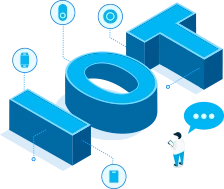Bluetooth beacons are wireless signal transmitters that broadcast their presence and location information to nearby devices. They use Bluetooth Low Energy (BLE) technology to communicate with other devices and can be used for indoor positioning and tracking. In this article, we will explore the definition and working principles of BLE beacons, as well as the various types of beacon protocols and location technologies. We will also discuss the different forms of power solutions and the potential applications of this technology in different industries. Additionally, we will look at the advantages and disadvantages of using Bluetooth low-energy beacons, the future development trends of this technology, and how to choose the right types of beacons for specific needs.
What is beacon?
A Beacon is a small Bluetooth device that transmits a signal repeatedly so that it can be seen by other devices such as smartphones. Every 1/10th of a second, the beacon sends a radio signal that consists of a mix of letters and numbers. All smartphones “see” the beacon when they receive the signal, just as sailors see the light from a lighthouse.
Beacons provide advertising, facilitate navigation, and gather customer information. One of the best ways to interact with a customer in the real world is through beacons. Based on a person’s location, they start and deliver proximity advertising to his or her phone. Beacons also boost client engagement and gather crucial information about consumer behavior.
Beacons offer more precise location data than systems based on the Global Positioning System (GPS) and can be utilized for indoor locations. There are many different kinds of beacons, which can be categorized according to their types of Beacon protocol, shapes, power solution, location technology, and other factors.
Types of beacons protocols
iBeacon (Apple)
In December 2013, Apple revealed the market’s first beacon protocol and they named it iBeacon which works with both IOS and Android. It comes in a variety of forms, including miniature coin cell devices and USB sticks. The license criteria for iBeacon are guaranteed. To make an iBeacon device, a manufacturer’s license from Apple is required, as well as licensing requirements for the iBeacon logo.
AltBeacon protocol (Radius Networks)
It is Radius Networks’ proposal for an open and interoperable specification for proximity beacons. Its primary objective is to promote a wide market for beacon use cases. Anyone can use it for free and put beacons into use by using their technology. AltBeacon makes it possible to have application-specific UUIDs rather than company-specific ones by enabling the option to modify the business ID.
Eddystone (Google)
In July 2015, Google unveiled Eddystone, formerly known as UriBeacon. It embraces the capabilities of iBeacons and gives them even more real-world context. Eddystone supports beacons capable of transmitting three different frame types for iOS and Android. One, two, or all three frame types may be sent by a single beacon.
The table below compares these protocols based on their features, advantages, and disadvantages.
| Protocol | Features | Advantages | disadvantages | Suitable for |
|---|---|---|---|---|
| iBeacon | Proprietary protocol from Apple | Widely supported, Not complicated to implement, Proven performance on iOS. | Limited compatibility with non-Apple devices | Retail, Indoor navigation |
| AltBeacon | Open source protocol | Customizable, Flexible, Platform-agnostic | Requires additional configuration | Smart homes, Healthcare, Logistics |
| Eddystone | Open source protocol | High resolution, coordinates, TLM-Data support (Battery life), 8 Bytes of user data | Limited compatibility with older devices | Retail, Proximity Marketing |
Types of beacon wireless technology
There are several wireless communication protocols used for beacon technology, including BLE, LoRa, NFC, LTE, RFID, UWB, GPS, and Wi-Fi. The table below compares these technologies based on their features and applications.
| Technology | Features | Applications |
|---|---|---|
| BLE | Low power consumption, Short-range communication |
Retail, Proximity notifications, Mobile payments, Asset tracking, Indoor navigation |
| LoRa | Low power consumption, Long-range communication |
Smart cities, Agriculture, Asset tracking |
| LTE | High-speed data transmission, Long-range coverage |
Industrial automation, Logistics, Tracking |
| RFID | Contactless communication, Easy to integrate |
Retail, Identification, Inventory management, Access control |
| UWB | High-precision location tracking, Short-range |
Asset tracking, Safety monitoring |
| GPS | Global coverage, Outdoor location tracking |
Navigation, Tracking |
| WI-FI | High-speed data transmission, Medium-range coverage |
Retail, Indoor navigation, Asset |
| NFC | Low power consumption, Short-range communication |
Payments Delivering information at a tap, Security Checkpoints |
Types of power solutions for beacons
In general, there are three different ways to power beacons: battery-powered, plug-powered, and USB-powered. Beacons that are battery-powered can be powered in a variety of ways, including using coin cell (or Button cell) batteries, and AA, or AAA batteries.
Different shapes of Bluetooth beacon
Beacon devices can have different shapes, including:
Card beacon
These are thin, card-shaped beacons designed for discreet placement in certain areas.
Wristband beacon
These are worn around the wrist, making them useful for events or theme parks that require easy tracking of guests.
Sticker beacon
These are small and flat, designed to be attached to items such as products or equipment for tracking purposes.
USB beacon
These are designed to fit into a USB port and are often used for tracking laptops or other mobile devices.
Key Fob
These look similar to a keychain and are small enough to fit on a keyring, making them ideal for tracking keys or other small items.
Badge beacon
These are designed to be worn like a badge and are useful for tracking the location and movement of employees in certain industries.
Overall, the choice of Bluetooth beacon shape depends on the specific use case, application, and placement requirements. The size, shape, and form factor of Bluetooth beacons plays a key role in optimizing their use and effectiveness.
Applications of Bluetooth low energy Beacons
Beacon technology has been widely adopted in various industries and applications, including retail, hospitality, healthcare, transportation, and logistics, among others. Here are some of the most common use cases for beacon technology:
Indoor Navigation: Beacons can help users navigate indoor spaces such as shopping malls, airports, and hospitals by providing location-based information and directions.
Proximity Marketing: Retailers can use beacons to push targeted promotions and personalized offers to customers based on their location and behavior.
Attendance management: Beacons can be used to check in for easier management of employees and visitors.
Asset Tracking: Beacons can be used to capture data that is more accurate than GPS or WiFi signals, allowing you to see how and where your consumers are moving around your store.
Analysis & Data Collection: Beacons can be used to monitor building occupancy, temperature, and energy consumption to optimize building performance.
Geofencing: Messages (either to application users or property owners) about a safety issue can be transmitted automatically by Beacons, such as ensuring patients don’t go in the incorrect wing or warning industrial workers of harmful developments. Moreover, beacons and geofencing can be used to increase data security.
![]()
Advantages and disadvantages of Bluetooth beacons
Beacon technology, like any other technology, has benefits and drawbacks. The following is a list of some of the more noteworthy ones:
Advantages:
- Beacon’s location tracking is precise.
- Most platforms based on the beacon technology can be easily deployed and customized to the client’s needs.
- Low power consumption is required when the Bluetooth beacon works
- When compared to other technologies, beacons offer excellent prices and value.
- Beacon can be used in multiple cases.
- Beacon can provide personalized experiences and promotions.
Disadvantages:
- If beacons want to play a role, user authorization is required
- Sometimes, signal interference from other Bluetooth devices will appear.
- Data transmission capabilities and range is limited.
- An app is required to be installed by customers so that they can engage themselves in proximity marketing with beacons.
How much do low-energy Bluetooth beacons cost
The cost of low-energy Bluetooth beacons can vary depending on a few factors such as the brand, model, quantity, and features. Generally, the price for a single low-energy Bluetooth beacon ranges from $3 to $40, with most options falling in the $10 to $20 range.
The least expensive Bluetooth beacons usually come with basic features such as short-range and small battery life. Whereas, higher-end beacons may offer a longer battery life, wider range, and additional features such as temperature sensors, motion sensors, or ambient light sensors.
It is important to keep in mind that the prices of Bluetooth beacons may also be influenced by factors such as the manufacturer, certifications, compatibility with different systems, and customizations that may be needed for specific business use cases.
So, it is recommended that the users should survey different vendors, compare product features, and read reviews before making a purchase decision.
![]()
Future development of Bluetooth beacons
The future development of Bluetooth beacons is likely to focus on improving distance measurement and indoor positioning accuracy, reducing power consumption, and lowering costs. Bluetooth 5.1 introduced direction-finding capabilities, which can enable sub-meter accuracy in location-based services. The upcoming Bluetooth 5.2 standard is expected to enhance these capabilities further, enabling more precise location tracking and reducing interference.
Bluetooth beacons are also likely to integrate more sensors and data processing capabilities, enabling more sophisticated applications. For example, some beacon manufacturers are developing beacons with temperature, humidity, and air quality sensors for use in environmental monitoring applications.
How to select the right BLE beacon type?
Choosing the right beacon type depends on several factors, including distance requirements, power consumption, data transmission speed, reliability, budget, and application scenario. For example, if you need to track assets or people in a large area, such as a warehouse or a stadium, a long-range beacon may be more suitable. On the other hand, if you need to track items in a retail store or a museum, a short-range beacon may be more appropriate.
Considerations such as battery life and signal interference should also be factored in when selecting the right beacon type. For instance, a wearable beacon may be more suitable for tracking employees in a factory than a sticker beacon, which may fall off or get damaged. Similarly, if you need to transmit large amounts of data, such as multimedia content, Wi-Fi or NFC-based beacons may be more appropriate than Bluetooth-based beacons.
Why choose Bluetooth beacon from MOKOSmart?
If you’re considering implementing a Bluetooth beacon solution, it’s essential to select a reliable and reputable manufacturer. Our Bluetooth beacons offer several advantages, including:
High-quality hardware: Our beacons are built with high-quality components and undergo rigorous testing to ensure they meet the highest standards.
Advanced features: Our beacons offer advanced features such as multi-sensor data collection, long-range connectivity, and sub-meter location accuracy, enabling a wide range of applications.
Easy-to-use software: You can effortlessly set up and maintain your beacons with the help of our user-friendly and simple beacon management software.
Flexible customization: We offer a variety of customization options, including form factor, color, and logo, to meet your exact requirements.
Strong R&D team: With the use of Bluetooth beacons, wireless modules, IoT gateways, smart plug switches, and other devices, our team hopes to advance the IoT network to a new level and link the entire planet.
Excellent support: Any inquiries or problems you may have can be addressed by our technical support staff, who are available around the clock.
Conclusion
Bluetooth beacons are a versatile and powerful technology that can enable a wide range of applications, from indoor navigation and asset tracking to proximity marketing and social networking. Choosing the right beacon type depends on several factors, including distance requirements, power consumption, data transmission speed, reliability, budget, and application scenario. By selecting a reliable and reputable manufacturer and considering your specific needs and requirements, you can implement a successful Bluetooth beacon solution that can provide significant benefits to your business. Contact MOKOSmart for customizable beacon solutions!
Continue Reading About Beacons
- Bluetooth 4.0 beacon vs Bluetooth 5.0 beacon-A detailed comparison
- BLE Beacons vs Other RF Beacons: Why Choose Low Energy Bluetooth Beacons
- Eddystone vs. iBeacon -Which One Should You Choose
- RFID Beacons vs Bluetooth Beacons: Which is Right for Your Application
- How iBeacon Technology Works: The In-depth Breakdown





























